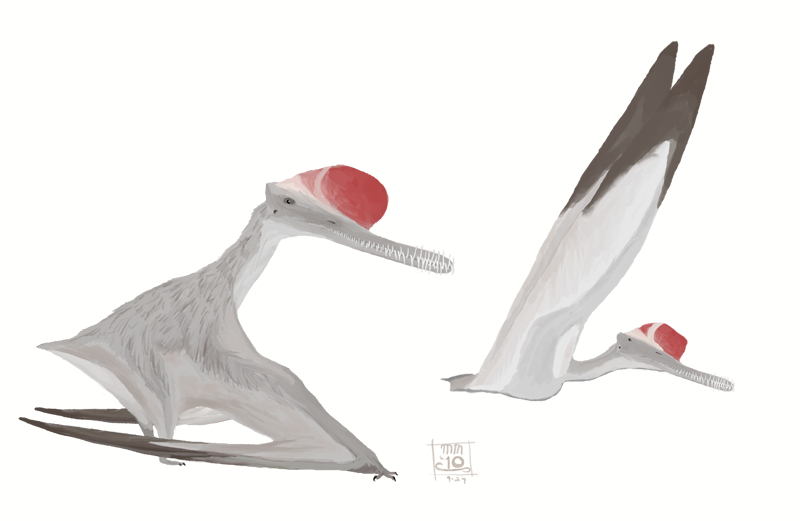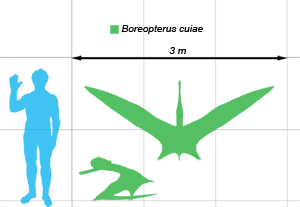[Recent Entries][Archive][Friends][User Info]
| April 30th, 2014 | |||||||||||||||||||||||||||||
|---|---|---|---|---|---|---|---|---|---|---|---|---|---|---|---|---|---|---|---|---|---|---|---|---|---|---|---|---|---|
| 03:05 pm [industrialterro] [Link] |
Boreopterus Boreopterus is a genus of pterodactyloid pterosaur from the Barremian-Aptian-age Lower Cretaceous Yixian Formation of Dalian, Liaoning, China. The genus was in 2005 named by Lü Jinchang and Ji Qiang. The type species is Boreopterus cuiae. The genus name is derived from Greek boreios, "northern" and pteron, "wing". The specific epithet was chosen to dedicate Cui Xu. The genus is based on holotype JZMP-04-07-3, a nearly complete but crushed skeleton and skull. The skull is 235 millimeters long (9.25 inches), low and elongated with a rounded tip. Its wingspan is estimated to have been around 1.45 meters (4.76 feet). Its teeth, especially the anterior nine pairs, are quite large, forming a mesh of sharp teeth at the front of the mouth; the third and fourth teeth from the front are the largest. There are at least 27 teeth in each side of both the upper and lower jaws, which is a large amount. Lü and Ji initially placed Boreopterus in the Ornithocheiridae when they described it in 2006, a classification which was supported later that year by David Unwin. However, Lü in 2006 published a cladistic analysis showing Boreopterus to be the sister taxon of Feilongus (together forming the new family, Boreopteridae) in a position more basal than Haopterus. In 2013, a more comprehensive study of pterosaur relationships supported the close relationship of Boreopterus and Feilongus, as well as their relatively basal status among pterodactyloids. Andres & Myers (2013) found the "boreopterids" as the sister group of Cycnorhamphus within the archaeopterodactyloid group Gallodactylidae. Pterosaurs like Boreopterus are interpreted by Unwin as soaring animals, like today's albatrosses and frigatebirds. However, it has also been suggested that boreopterids foraged while swimming, trapping small prey with their needle-like teeth, a method similar to that of modern Platanista dolphins. It has been suggested that the closely related Zhenyuanopterus was merely the adult form of this animal. Boreopteridae (meaning "northern wings") is a group of ornithocheiroid pterosaurs from the Aptian-age Lower Cretaceous Yixian Formation of Liaoning, China. In 2006, Lu and colleagues named the clade Boreopteridae for the clade containing the common ancestor of Boreopterus and Feilongus and all its descendants, which the authors reclassified as close relatives of the ornithocherids. (Feilongus had originally been considered a gallodactylid). Many possible boreopterids were subsequently described, one possible example being Aetodactylus, which has been claimed to be similar to Boreopterus. Originally considered close relatives of the ornithocheirids, many of these supposed boreopterids have been found to belong to other groups of the pterodactyloid lineage. Boreopterus and Feilongus were found by Andres and colleagues in 2013 to be closely related to Cycnorhamphus, making them members of the Gallodactylidae as had been originally thought when Feilongus was discovered. A subsequent analysis including the other supposed boreopterids found that Boreopterus itself, and therefore the name Boreopteridae, was indeed a member of the ornithocheiroid clade, but that Feilongus was in fact a ctenochasmatoid closely related to Gnathosaurus. According to Andres and colleagues (2014), the true boreopterid clade is limited to Boreopterus, Guidraco, and Zhenyuanopterus. The known taxa come from the Yixian Formation of Liaoning, which represented a lake system, suggesting that these animals occurred in freshwater habitats. They are thought to have foraged while swimming, trapping prey with their needle-like teeth; this method of fishing was probably analogous to that of Platanista dolphins, which share a similar dentition. Many possible ornithocheirid remains might actually belong to boreopterids, a possible example being Aetodactylus, which has been claimed to be similar to Boreopterus Размеры тела в сравнении с человеком: Tags: Вымершие рептилии, Мел, авеметатарзалии, архозавроморфы, архозавры, бореоптериды, диапсиды, монофенестраты, орнитохейройды, птеранодонтойды, птеродактили, птерозавры | ||||||||||||||||||||||||||||
| Comments | |||||||||||||||||||||||||||||
хули научную работу про палеогафурок потёр, ты, обида ёбаная? (Reply to this) (Thread)
потому что он сам ебучая гафурка, вот ему пукан-то и припеклоу
Сочный баттхерт анонимного говна весьма и весьма приятственен. (Reply to this) (Parent) | |||||||||||||||||||||||||||||




